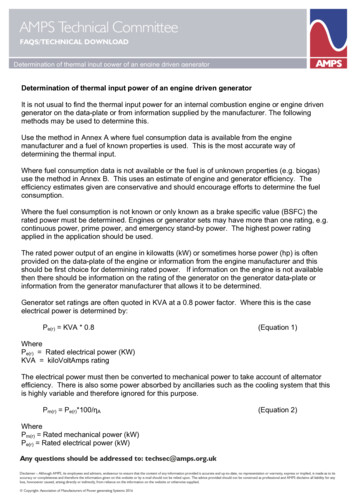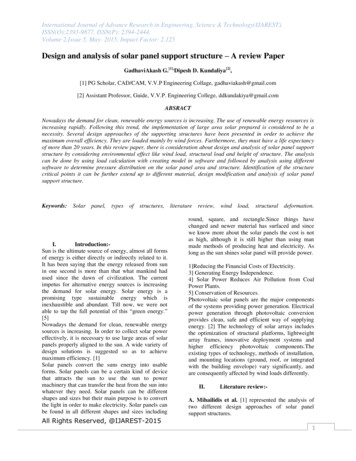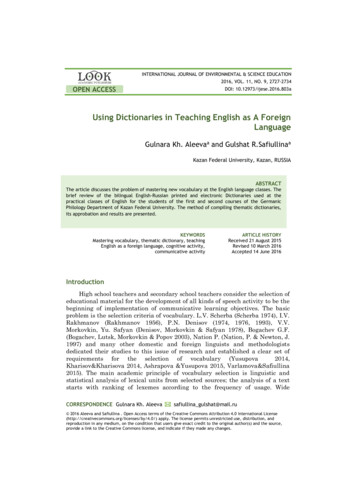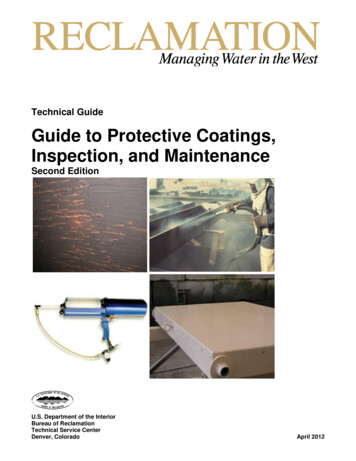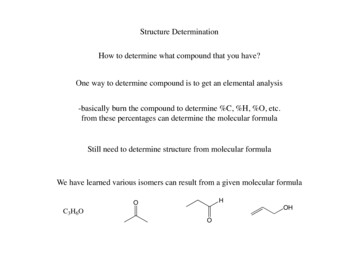
Transcription
Structure DeterminationHow to determine what compound that you have?One way to determine compound is to get an elemental analysis-basically burn the compound to determine %C, %H, %O, etc.from these percentages can determine the molecular formulaStill need to determine structure from molecular formulaWe have learned various isomers can result from a given molecular formula
Structure DeterminationNeed methods to distinguish between possible structuresA nondestructive way is to use absorption spectroscopyIn a simplified picture:The ability of the sample to absorb incident radiation is measured by the difference inabsorbance at the detector versus the blank
Electromagnetic SpectrumAll light travels at a constant speedThe difference is the wavelength of the light(which also determines the energy of the light)E hν (hc) / λ
Infrared RegionWavelength of infrared radiation is 800 cm-1 to 4000 cm-1 wavenumbers(wavenumbers correspond to number of wavelengths of light in 1 cm)-common descriptor for IR frequencies by organic chemistsAs the wavenumber becomes larger the energy increasesThe energy level of infrared light corresponds to the energy requiredto cause molecular vibrationsDepending upon what type of bond is present determinesthe exact energy required to cause the vibrationThe energy of light absorbed therefore indicates what functional group is present
Bond VibrationThe energy of the infrared light can interactwith the resonant vibrational frequency of the bondSince different bonds have different energies,they require different energy to cause vibrationconsider acetoneOOH3CCH3The carbonyl has a strong dipoleH3CCH3EWhen electric field aligns withdipole, bond shortensThe absorption of the infrared light thuschanges the dipole for this bond as it vibrates
Active versus InactiveIR only causes a vibration if there is a change in dipole during vibrationTherefore symmetric bonds are inactiveCH3-CH3the carbon-carbon bond of ethane will not observe an IR stretchOr any other symmetric bondAn IR “active” bond is therefore a bond that changes dipole during vibration,While an IR “inactive” bond is a symmetric bond that doesn’t change dipole during vibration
Number of VibrationsThe number of possible vibrations for a given moleculeis determined by the number of atoms presentFor nonlinear molecules obtain 3N-6 vibrations(N equals number of atoms present)3N-5 vibrations for linear moleculeFor example consider acetone again (C3H6O1)Acetone has 10 atoms and is nonlinearTherefore expect 3(10)-6 24 vibrations
Intensity of AbsorbanceIntensity of light absorbed by a molecule is related to the dipole of the bondThe greater the dipole, the greater the absorbance intensityC-O bond stretches are therefore more intense than C-C stretchesRealize the intensity of absorbance is not related to the wavenumberThe wavenumber is related to the force constant for the bond vibrating(the stiffness of the bond)
Factors to be considered in an IR spectrum1) Position of absorbance (wavenumber)Energy required for absorbance2) Intensity of absorbanceRelated to the dipole of the bond3) Shape of absorbance(broad or sharp peaks)Tells information about the type of bond
Specific Functional GroupsAs mentioned specific functional groups have characteristic absorbance frequenciesConsider carbon-carbon bondsAs the number of bonds increases between two atoms,the stiffness of the bond increases which results in a harder bond to stretch
Conjugation lowers the stretching frequency(RESONANCE!!!)
C-H Bond StretchingAs the %s character increases in a bond, the bond becomes stiffer(already saw that sp hybridized C-C bonds are stiffer than sp3 hybridized C-C bonds)Same is true for carbon-hydrogen bondssp3 hybridizedsp2 hybridizedsp hybridized2800-3000 cm-13000-3100 cm-1 3300 cm-1Key point: only sp3 hybridized C-H bond stretches are below 3000 cm-1
Alcohols and AminesBoth O-H and N-H bonds are “stiff” bondsTherefore they have a higher vibrational frequenciesAlcoholAcidAmineRO-HRCO2-HRN-H 3300 cm-1 3000 cm-1 3300 cm-1
Both N-H and O-H bonds are involved in hydrogen bondingDue to this hydrogen bonding, each individual O-H bondwill have a slightly different vibrational frequencyTherefore this causes the appearance of a broad peak
Amine peaks show the same broad features(N-H bonds are also involved in hydrogen bonding)Difference is that often observe a sharp peak in the midst of the broad peak(due to one conformation of hydrogen bonding having a preferential formation)
Carbonyl CompoundsOne of the best diagnostic features of IR is for carbonyl compoundsRemember there are many types of carbonyl groups(each can be differentiated only with an IR spectrum)OR! e17151720171517351660
Carbonyl CompoundsDue to the large dipole of carbonyl bonds, all carbonyl groups display strong,relatively sharp peaksC Olarge dipoleC Csmall dipoleMost carbonyl stretching frequencies are centered around 1710-1720 cm-1 and can bedistinguished easily from alkene stretches ( low 1600’s cm-1) due to both the higherfrequency and the more intense absorbance
Carbonyl CompoundsSome carbonyl stretching frequencies are noticeably different than 1710-1720 cm-1Esters are one typeEsters have an appreciably higher stretching frequencyHigher frequency means a “stiffer” bond
Carbonyl CompoundsWhat causes a “stiffer” carbonyl bond?Substituents on the carbonyl carbon can affect the C O bond stretch in two ways:Inductive effectResonance effectOORRYOYRYMore electronegative Y pulls electron density Lone pair of electrons on Y atom can resonatefrom carbon, which then pulls electrons from to create a C Y double bond and thus a C-Ooxygen to create a stiffer bondsingle bond – therefore a weaker C-O bondThe question is which effect is largerGenerally the greater difference in electronegativity between C and Ycauses inductive effect to become dominantYν (cm-1)Stronger ce
Carbonyl CompoundsAmide group lowers the frequency due to the resonance effectIf a nitrogen is attached to the carbonyl carbon then the lone pair of electronson nitrogen can stabilize the resonance formDue to this lower energy resonance form the carbonyl carbon-oxygen bond is less “stiff”,therefore the stretching frequency is LOWER
Carbonyl CompoundsResonance with extra conjugation will also lower the stretching frequency for a carbonylResonance allows delocalization of π electrons,therefore carbonyl is less “stiff”
Other Diagnostic Peaks for Carbonyl CompoundsAs already observed many carbonyl groups are 1710-1720 cm-1How to distinguish?OROORKetone 1715 cm-1 for carbonylRHROHAldehydeAcidobserve aldehyde C-H stretchobserve broad O-H stretchTwo peaks at 2700 and 2800 cm-1 3000 cm-1
Small RingsSmall rings also have a shift in vibrational frequency to higher energy,Therefore 5,4, or 3 membered rings have the carbonyl stretching frequency shiftedO1715 cm-1O1745 cm-1O1785 cm-1Angle strain in these rings causes the carbonyl group to have more electron density,Therefore a “stiffer” bond
C-N BondsC-N bonds are in similar regions to C-C bondsThe intensity of absorbance, however is higherdue to greater dipole of C-N bond compared to C-C
Fingerprint RegionThe so-called “fingerprint” region is below 1500 cm-1Vibrations in this region are often complex and hard to assignto a specific functional group of the molecule-a given molecule, though, has a DISTINCT pattern in this region(reason for this region being called the “fingerprint” region)One common pattern – differentiating substitution isomersOrthoMetaParaOne example:Aromatic isomersone peak770-735 cm-1three peaks900-860, 810-750, 725-680 cm-1one peak860-800 cm-1
Fingerprint Region
Overtone and Combination BandsOvertone-when assigning IR spectra be careful to note overtone bands(an intense peak will display a smaller peak at a multiple [2x, 3x, etc.] of that peak)Combination BandsTwo or more vibrations can couple to cause a vibration at a different position(vibrations must be “coupled” to observe these combination bands)
Overtone Bands2nd Overtone 3430 cm-1Strong carbonyl stretch 1715 cm-1
PredictedIRDifferencesOOestercarbonylsp3C- ‐HbondsOOconjugatedestercarbonylsp3andsp2C- ‐Hbondssp2carbons
weakC- ‐Ctriplebondspandsp3C- ‐HbondsNstrongC- ‐Ntriplebondonlysp3C- ‐Hbonds
IsomersofC4H8O1OOH
Resonance effect! O RY Lone pair of electrons on Y atom can resonate to create a C Y double bond and thus a C-O single bond - therefore a weaker C-O bond! O RY The question is which effect is larger! Generally the greater difference in electronegativity between C and Y ! causes inductive effect to become dominant! Y! ν (cm-1)! Stronger effect!
